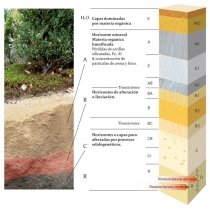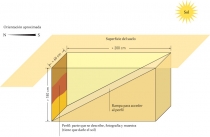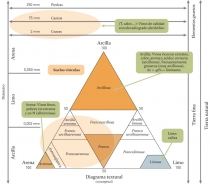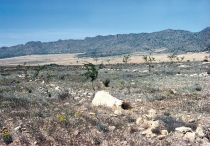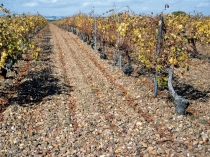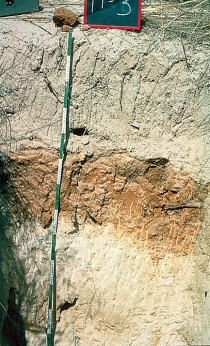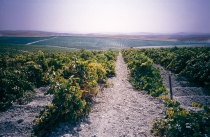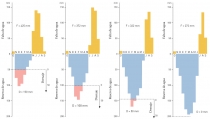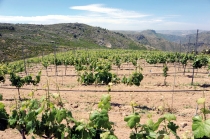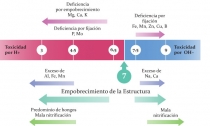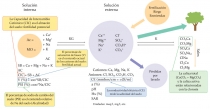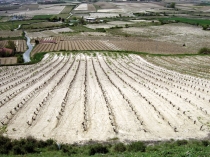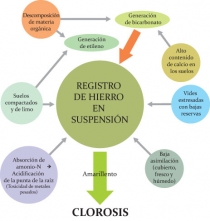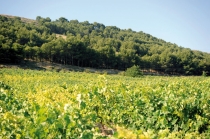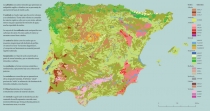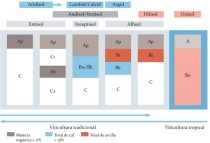The Influence of Soil on Wine Quality
The direct influence of the soil on the quality remains a much debated topic, albeit covered in exemplary fashion by Armstrong and Wetherby (1976). Without doubt, the progress of studies on isolating and determining individual parameters of the soil, and their influence, has provided some promising perspectives.
The traditional overall view of the subject of soil assumes that soil is to be understood as a result of the interaction, during a given period of time, between climate and living organisms as active factors, and rocks and topography as passive factors.
The direct relationship to the concept of terroir (see Fig. 122) is obvious in this sense, since even if one accentuates the significance of climate, geology, topography, or any one of the other factors mentioned above which influence the crop or quality of the product, one still has to acknowledge, even indirectly, the importance of the soil. Thus, the basic factors of these environmental media and their individual properties exert an influence on the grapevine and its products.
The Soil
The soil is neither more nor less justified a term than terroir, but it is a natural entity, and is described scientifically by two branches of soil science: edaphology and pedology, both of which study the scientific and technical aspects of soil, devoting particular attention to its composition, formation, development and geographical distribution. When speaking about soil one normally makes reference to the superficial layer of the lithosphere in interaction with the atmosphere, hydrosphere and biosphere – in effect, the edosphere, or pedosphere, as a natural link between the organic and the inorganic.
Soil sustains the life of plants, because it stores their food and water, and regulates the climatic influences (such as temperature and rainfall) on the plants themselves. It is fundamental to human activity, and it is evident that soil that has been appropriately treated using technological and other management methods forms the basis of forestry, animal husbandry and related technical planning, as well as general agriculture, and, in this particular case, viticulture.
Soil Analysis
Soil is analysed by profiling. The term profiling was coined in geology, and later adopted by edaphics. Farmers, gardeners, and even experts, think of the soil in terms of the surface, and only take note of the first few centimetres of the top layer, unlike edaphologists, who view soil as three‑dimensional, in terms of soil profiles. They are also interested in its geographical classification and the relationship between the different soil types.
A soil profile is a cross‑section or vertical slice of soil which cuts through all layers, and reveals them as they occurred and changed during the course of the soil’s formation (edaphogenesis, Fig. 141). These layers can be observed as being parallel to the surface of the ground and they can be quite clearly seen. Each individual layer is distinguished by its physical, chemical, mineralogical, and biological structure. All profiles comprise several horizons, or distinct layers, and each horizon is characterised by its respective properties. It is not entirely accurate (although common, and used here for that reason) to speak of soil properties, since one and the same soil has different textures and compositions, such as organic matter, for example.
In order to study a soil, a pit must be dug with a soil profile (Fig. 142). This allows the soil to be evaluated as a whole, and to examine it from the most sun‑ exposed side, then to identify the slope and appearance of its horizon composition. Capital letters are used to refer to each of the main horizons, with lower‑case suffixes for secondary classifications within a particular horizon.
The main goal is to describe the taxonomic unit (soil type, see below) by making a complete macromorphological description of both the visible and measurable properties in the field, and a micromorphological description quantified by laboratory analysis results. The characteristics and components to be described vary greatly, depending on the purpose of the exercise.
Many of the properties can be observed in soil analyses. The following section will cover those properties which have the greatest influence on the vineyard and the quality of the wine.
Granulometry (study of the grain structure and size distribution).
One often reads that the vine seeks looser, deep soils and prefers stony soil to loam clay.
Specious arguments abound, however, and therefore this topic merits greater attention. Granulometry (in respect of the skeletal fraction and fine earth fraction) correlates heterogeneous variables and constituents of the soil, as well as physical, chemical, and physiochemical elements, aspects relating to plant toxicity, temperature, and hydric balance (Fig 144).
Stoniness (skeletal fraction) is a significant feature in soil, in relation to the climate and difficulties with water run off, erosion, and infiltration. There are obstacles to the formation of capillary action, and differences depending on soil texture; hence, for example the ability of calcareous soil to store water and the lower specific heat coefficient of gravel (Fig. 146), as in the D.O. Rueda region. In terms of wine, stony soils generally benefit quality, even though they have the disadvantage of limiting the vigour of the vine, its fertility and therefore its yield.
With respect to the fine earth fraction (grains smaller than 2 mm), it can be assumed that vines prefer those loose sandy, well drained soils, for which, however, dryness is not a limiting factor. The uniformity of the profile is very important, but on matters of detail, different situations can be observed depending on the relative proportion of clay, its thickness and the horizon limit. (Fig. 144: Soil textural triangle).
With regard to clay, Fregoni (1973) wrote that high clay soils ought to be associated with extract‑ rich, aromatic, colour intensive, but often clumsy wines. Because plant growth and development are often influenced by morphological and physical problems, the upper limit for the proportion of clay soil is normally set at 45%, although an overview of the most important viticultural soils of the world reveals that major exceptions to this general rule may be found (Fig. 148: Calcareous soils in the D.O. Jerez D.O. region).
In areas with predominantly sandy soils there is a low proportion of clay, which gives rise to noticeable cultivation problems because of lower fertility and water management, with the attendant risks to the quality of the wine produced.
Soil structure and texture refers to the formation of stable conglomerates over water with a direct effect on the vine’s root system. Formations of strong prismatic (vertical pillar shape) and laminar (layered) character will have a negative effect on the crop.
The deterioration of the texture of the soil’s top horizon is primarily caused by tillage, slope, erosion, and loss of organic material, all of which promote the formation of superficial crust, which in turn hinders the soil permeability in respect of water and air, and influences the choice of planting methods.
The soils of most sandy plots are usually hardened, or very hard and crusty, when dry. Soil analysis is determined by far‑reaching causes such as clumping and the creation of the surface crusts (clay‑loam) already mentioned, particularly when the coarse components on the surface are fragile in structure which would otherwise stop the process of soil degradation. This problem is apparent in the levelling and geometric repair of plots, including drastic measures such as reduced tillage of the soil.
With regard to effective depth it is sometimes said that the vine root system rarely exceeds a depth of 1.20 m, and in general, 90% of the vines are within the top 60 cm, and the main roots found at depths between 20 and 60 cm. This is not always the case. As long as soil conditions allow (the absence of surface crusts is an insignificant factor here), major root development takes place at depths greater than one metre, ensuring good utilization of the soil and guaranteeing a proper supply of nutrients and water. Regional problems arise regularly in valley basins or depressions (hydromorphic conditions, or flooding), so the use of reservoirs to control surface water is recommended, especially for larger plots, and particularly when used to advantage in lowlands with nearby ground water, thereby improving effective depth and management of vineyard operations
Soil climate includes climatic components and their effect on the soil (and vice versa) as well as their interaction with appropriate modifications as regards the crop, thus determining quality. The majority of the climate‑induced modifications which occur in the soil can be linked in the medium to long term to the processes of change and eluviation (outwashing): in the profile (effective depth, differentiation of horizons, contrasts, etc.), in the physical properties (design and structure, porosity, colour, etc.), in the organic material (accumulation, humidification, mineralization); and the solubility of the soil (dilution or concentration) with the pH value and ways to correct it (change in fertility from actual situation to potential target situation).
The significance of these modifications obviously depends on the direction of change and the end result, which determines the quality of the product, and what form this takes. Other determinants include modifications that the soil itself undergoes depending on the response of the plant to the climate, hence the term edaphoclimatic, when speaking of the climate of the soil in relation to its temperature, aeration, and humidity.
Generally, the soil functions as the regulator of climatic determinants because of its properties: irradiance (heat, sunlight reflection); temperature (specific heat); rainfall/water supply (granulometry, retention capacity); and evapotranspiration versus water intake (physical properties, capillarity and richness).
As stated above, the temperature regime of the soil is significantly different from that of the external environment, and allows root growth to begin and slow down before growth occurs in the plant above ground.
Soil temperature is influenced by several factors, such as colour, the specific heat of the materials which make up its composition (water, organic material, whether its surface is covered with vegetation and coarse material), and topography. In terms of the dual aspects of heat and temperature, one can assume that the grapevines that grow in dark soils [terra preta] (lowlands, valley basins) exhibit better development, have more vigorous growth, darker leaf colouring, and a warmer tonality, but have a lower risk of scorching, loss of vigour and premature ending of vegetative growth because of increases in temperature.
Soil humidity can be viewed as a result of equilibrium between water uptake (rainfall, precipitation, groundwater and irrigation) and water loss (seepage, evapotranspiration and drainage). The soil and its properties (composition, structure, porosity and depth) should be seen as a regulating agent, because of the role it plays in the vineyard. This regulatory factor is crucial in the Iberian Peninsula given the lack of rain during the key months of the vegetative cycle. The lack of moisture during all seasons is responsible for slow development, low production, high sugar content and lack of acidity in wines.
Basic findings reveal that the control of water supply in the vineyard plays an important role in the development of the vine for much of its growth, and in the development of its wine quality. In this sense, hydric balance is an important tool for vintners in terms of proactive water management. The vintner needs to take into account evaporation and transpiration, and loss from seepage and drainage, in relation to the field capacity of the vineyard soil in order to be able to provide an adequate water supply tailored to each specific stage of vine development. It is also an important source for providing possible parameters for zoning methods (see below): water supply, avoidance of water deficits, and prevention of excessive water up to a certain point in time, etc.
By way of illustration, in a specific region the hydric balance is effected as a function of its moisture constant for each soil, and makes it possible to analyse the different underlying causes in variations which define the terroir itself such as difference in growth cycle or deviations from the norm in those years when the soils were examined. For example, sandy and/or shallower soils – with small water reserves – lose a lot of moisture long before the deep, clay soils with large water reserves. (Fig. 149: Difference in the humidity balance in different soil types.)
The Colloidal Systemconstitutes a centre of soil fertility and is made up of organic colloids (organic matter, humus) and colloidal minerals (clays). In regard to organic colloids, it is often said that rich organic soils produce clumsy wines. Other authors have attempted to show a relationship between the nature of the soils and the polyphenol content of the grapes produced. They have determined that nitrogen‑ rich soils lead to poor, low extract wines and wines with low anthocyanin content. Nevertheless, it appears that humus in itself appears not to be a negative factor in influencing wine quality, especially in clay soils. In this regard, some experiments confirm that the cations, where organic acids are in equilibrium, can bring about a change in the chemistry of the plant in line with soil properties, the probability of which depends on the number of ions absorbed.
Soils with a high level of organic material promote colour intensity and increase tannin levels in must, but viewed overall the improved vegetative and productive development may lead to reduced quality by reason of high fertility. A large number of vineyard soils on the Iberian Peninsula are calcareous, and humus on such soils is stabilised by active lime and is difficult for bacteria to mineralise (degrade). The annual rate of mineralization is much lower than that of other vineyard soils. For this reason, this type of vineyard soil requires excessive amounts of nitrogen in order to guarantee a balanced nitrogen supply. Other reasons are responsible, however, for similar problems with nitrification experienced in acidic soils (Fig. 152: pH value and soil properties). At the same time, it is common to compare phosphorus values with those of the organic material, and if the pH values are low, compaction problems may exist over the entire depth.
The importance of the pH value of the soil on wine quality should be recognised. The pH of the soil taken in isolation provides neither a benchmark for the health of the soil nor for the nutritional balance of the plant, nor for the quality of grape, must or wine. All over the world, as well as on the Iberian Peninsula, quality red and white wines come from acid, neutral and alkaline soils. Yet there is a relationship between the pH of the soil, important structural features and nitrification levels. These serve as indicators of predetermined nutrient balance, various shortcomings and toxicity, which will in turn be reflected in the wine quality (Fig. 151).
The mineral colloid relates to fertility and availability of nutrients, which affects the soil and soil nutrient balance, and therefore acts on yield and quality.
Soil fertility is a complex phenomenon linked to and influenced by external variables (climate, geographical location, crop), as well as by the physical, chemical and physiochemical properties of the soil, including the presence or absence of certain nutrients. It is said that the best wines are produced on poor soils with few assimilable elements, and some experts even claim that the quality of wine stands in inverse proportion to the productivity of the vineyard soil.
One can consider this claim though, but only from the perspective of it being right or wrong. In this regard it is considered viticultural dogma that good wines are produced in poor calcareous soils. There are circumstances, however, amongst which are extreme soil situations, in which it is impossible to produce balanced wines, not to mention the fact that fine wines can be produced on fertile soils. Ultimately, whether on fertile or poor soils, all that is required is the incorrect or correct application of certain substances which correspond to the vegetative characteristics of a balanced or unbalanced crop in order to obtain a low or high yield of poor or good quality.
In this respect, the technology is crucial, beginning with analytical soil data. Consideration has to be given to the fact that the amount of nutrients available to the roots is just as important as the proportion of each nutrient available. The lack of nutrients in the upper layer of the soil promotes deep root growth, and this in turn allows a greater regularity of vineyard water supply, which is ultimately to be regarded as a quality factor.
All these issues are regulated by the ion balance of the soil. (Figure 152: Soil balance in relation to fertility and treatment). The ion balance (the Gapon constant, KG) is determined by the interplay of an “internal” solution (the organic‑mineral exchange complex) and an “external” solution (soil solution), which is influenced by supply (irrigation, liquid fertiliser, etc.) or removal (nutrient removal, leaching). Thus, potential fertility corresponds to the cation exchange capacity (CEC) which is determined by the sum of cations or bases (SB) and pH dependent loading. Current soil fertility corresponds to the base saturation level (V), which correlates the base total with the CEC. Alkalinity is measured as a percentage of the exchangeable sodium (PSI), which in turn corresponds to the sodium saturation of the CEC. Similarly, the external solution is also in equilibrium (equilibrium constant K) with the precipitated soil salts (lime, gypsum, etc.); whereby this equilibrium is measured in the water saturation of the soil and serves as a benchmark for the other variables which include: soil acidity (pH), salinity (electrical conductivity, cation exchange [CE]), the soluble anions and cations, and the sodium saturation coefficient.
Often, the nutrient status of soil is very heterogeneous in its spatial distribution, and it is therefore obvious that despite the existing amounts of certain nutrients, neither the nutritional balance nor yield will be good if the soil lacks a single nutrient. In line with Liebig’s Law of the Minimum, an insufficient quantity of just one element is enough for the soil to behave as if it is completely low in nutrients.
The components which determine soil fertility are also crucial to wine quality. This means that in order to investigate a specific situation we need to take into consideration the total value of the nutrients and their ratios to total capacity and, finally, the possible antagonisms between them. In terms of the absolute cation values, the following can be considered acceptable: calcium, 10‑20 cmol(+)/Kg; magnesium, 2.5‑5 cmol(+)/kg; and potassium, 0.6‑1.2 cmol(+)/ kg. The following are acceptable exchange ratios: exchangeable calcium, 40%‑70%; that of magnesium, 10%‑20%; and that of potassium, 2%‑12%; whilst the amount of sodium, which is related to soil alkalinity problems, should be between 0.5% and 3% (never over 10%). As a rule, two ratios are used to evaluate antagonisms in the vine: the ratio of calcium to magnesium should be 5, and that of magnesium to potassium between 0.5 and 1.
Plant intolerance (toxicity) from the excessive presence of aluminium in excessively acid soils, is particularly problematic when estimating productivity and efficiency. Factors influencing low productivity are limited availability of exchange bases and nutrients such as phosphorous, molybdenum and boron, as well as toxicity from aluminium, magnesium and hydrogen ions. A pH correction is therefore often required.
Chlorosis is the collective term used to refer to the lack of equilibrium in plant metabolism, and can be recognised by the yellowing of grapevine leaves. It may be caused by several different things. Despite extensive literature on this subject, no causal relationship has been established between excessive levels of calcium carbonate and insufficient chlorophyll synthesis.
Calcium chlorate is an important source of calcium; moreover the grapevine has specific requirements for this nutrient (quality factor), although it triggers iron chlorosis in grafted vines. Knowledge of the percentage of lime, the active calcium and iron content (a benchmark for the level of chlorosis) is most important when choosing a rootstock/graft combination.
The grapevine has moderate salt tolerance. In this sense, it is advisable to differentiate between the negative effect of salinity on yield and quality. This effect depends on the type of predominant soluble cations and anions: for example, the concentration of sodium and chlorine in the berries, and potassium and sulphur in the must, or a change in the pH value of either, etc.
In the vineyard there are problems with salinity values above 3 dS/m (although susceptibility of substrata varies). In the case of the presence of sulphur, however, even values of 2.2 dS/m can be disturbing. There are various kinds of salinity induced problems. First and foremost is the problem with vine physiology, since excess uptake of certain ions influences the must, and ultimately, the wine. Salinity also increases osmotic pressure, which can affect the vine’s water supply during the dry season because of the high hygroscopicity of salts such as gypsum.
The trace elements of primary importance in the vineyard are iron, manganese, zinc, copper and boron. Their availability to plants depends on the pH value of the soil (Fig. 151). In acid soils, most trace elements have a high plant availability. Nevertheless, it is recommended that symptoms of deficiency or toxicity be closely monitored from bud burst and the first stages of growth onwards.
Soil Survey
A comprehensive study of the soils of a region, an estate, or a small operation is usually called a soil survey, or if more detailed, a Soil Resources Inventory (SRI), and inevitably requires a detailed description of the soil and a pedological map.
The pedological map, or soil map, comprises a graphic with an explanatory legend, which is linked to a database. In summary, the different units of the graphic part of the pedological map are delineated. The common features of all delineations with the same description and content make up a cartographic unit, or soil map unit (SMU). The content of these cartographic units is precisely determined, and such units are referred to as soil taxonomic units (STU). A unit where the soils have very similar properties and uses is called a soil series and any deviation from the stipulated homogeneity of the soil series is called an inclusion.
Delineation of different units is achieved by means of various remote‑controlled sensors, depending on the scale (remote sensing, photo interpretation, radar, etc.), or directly through precise determination based on geomorphological criteria (primarily relief, rock, drainage) and other standards tied to particular properties observed in photographic images (texture, tone, colour, etc.).
The soil map contains information relating to the scale, the detail with which the survey was conducted, and the number of observations made. From the perspective of cartographic units, it is interesting to distinguish between two different scales: the large‑ scale map, on which the SMUs with their taxonomic units appear, showing the different soil types; and the small‑scale map, which necessarily presents an overview, and therefore only shows the main soil type, with possible inclusions of lesser significance. Small‑ scale maps are presented in general soil mapping format, without details.
Administrative institutions involved in the regulation of land use prefer to use small‑scale maps, which have to detail the areal proportion of the different taxonomic units. Large‑scale maps provide detailed soil mapping and are therefore of direct interest to the vintner in the management of his operations. The dividing line between small and large scale maps is normally considered to be at a mapscale of 1:25,000. At this scale, however, the delineation of the various units depends on, among other things, the diversity of the region, the availability of resources and the experience of the edaphologist. In soil mapping, it is not only the graphic representation, but also the legend or explanatory notes or annotations, which are important. These will be discussed in the following paragraph.
Vineyard Soils of the Iberian Peninsula
The completion of the Seventh Approximation Soil Classification System at the end of the 1950s marked the beginning of a new trend in soil classification, and today two major schools of classification co‑exist, known informally as the “American” system and the FAO system. Both have been revised and expanded. The two elements common to both classification systems are the definition of the classification parameters (properties, or characteristics and diagnostic horizons), and the more or less binominal structure. Although both are considered accurate, they are not comparable in terms of their respective structures or the bases of diagnosis used.
Of the two, the USDA method (Soil Taxonomy, 1975 – 2010) is considered the only one that can be used with any degree of success, not only in the general sense as discussed above but also in terms of detailed soil mapping, and therefore will be used here as a reference.
This classification system has several distinct categories: order, suborder, great group, subgroup, family, and series, according to which more than 16,000 soils around the world have been classified. Nine out of the twelve soil orders occur on the Iberian Peninsula. The geographical distribution of the corresponding suborders is shown in Fig. 156.
It is very important for two reasons that the classification is detailed enough; firstly, because the plants themselves are sensitive to small differences, and therefore behave differently from one terroir to another, and secondly, because applied management of the traditional vineyard, particularly precision viticulture, demands it.
Fig. 157 covers the main soils of traditional viticulture, some of which have been specifically expanded upon, since they have become interesting from the point of view of viticulture in tropical zones. For individual soil types, it shows the most characteristic soil profiles in traditional viticulture, based on only three properties that are most important in viticulture (organic matter, clay content, and calcium carbonate equivalents): Entisols (psamment, fluent) , Inceptisols (combixerept, calcixerept), Alfisols (Haploxeralfs, typical and calcic), Andisols, Vertisols, Aridisols (Cambids, Calcids, Argids) and Ultisols (Xerults). Those that apply to tropical viticulture are: Inceptisols (Ustepts), Alfisols (Ustalfs), and Oxisols. As can be appreciated, the Inceptisols and Alfisols are basically the same for both types of viticulture, humidity conditions notwithstanding, whilst Oxisols are clearly attributable only to tropical viticulture. Neither Mollisols (of greater significance in traditional viticulture) nor Spodosols (of significance in tropical viticulture) will be discussed here.
Based on the foregoing, it follows that neither the order, nor suborder, nor even the great group are suitable for viticultural use at a general, basic level; it is necessary to go to the level of the subgroup.
Ultimately, not even the subgroup is sufficient. There are, in fact, soil profiles from the same subgroup (calcareous Haploxeralfs). Even to the naked eye, clear differences can be observed in the thickness of the soil horizons, as well as effective depth, clay content, calcium content, soil stoniness, etc. These differences become even more pronounced when recourse is made to laboratory analyses to determine even more important characteristics, such as organic matter, the various grain size compositions, and potential and actual soil fertility, etc. Only when one goes into detail do these differences emerge. Ten different quality wine D.O. regions were surveyed and comparisons made between 46 of their most important viticultural soil series. The study revealed the greatest differences between soil series at supraregional level. Soil series from different D.O. regions were more dissimilar than soil series from within one single D.O. Region, although even within the same D.O. region wines of very different character have been produced.


